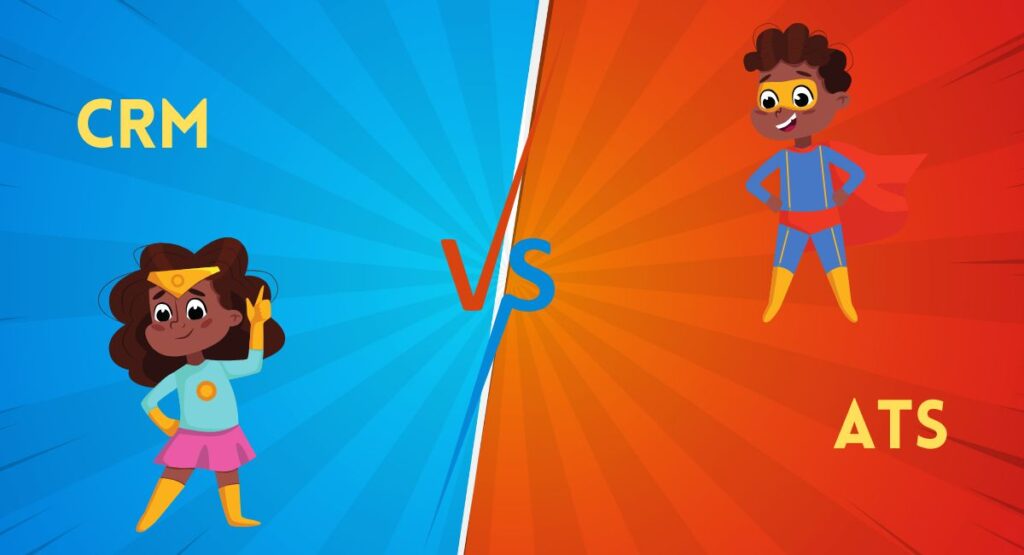- Home
- About Us
- Services
- IT, Digital & technologies
- Non- IT
- Staffing Service
- - Executive Search
- - Project Based Hiring
- - Direct Hire
- - Contract Hiring
- Contingent Staffing
- Outsourcing
- PF ESI Management
- Salary TDS Management
- Labour Compliance Outsourcing
- Compliance Management
Workforce Solution
Payroll & Compliance Management
BGV (Background Verification)
- Solution
- Blog
- Career Zone
- Contact Us
Recruiting CRM vs ATS: What Are the Differences, and When Do You Need Them Both?

Recruiting CRM vs ATS: What Are the Differences, and When Do You Need Them Both?
In the ever-evolving landscape of talent acquisition, two powerful tools have emerged as game-changers: the Applicant Tracking System (ATS) and the Candidate Relationship Management (CRM) system. While both play crucial roles in the recruitment process, they serve distinct purposes and offer unique benefits. This blog post will delve into the differences between these two systems and explore scenarios where having both can significantly enhance your recruitment strategy.
Understanding ATS and CRM
What is an ATS?
An Applicant Tracking System (ATS) is software designed to streamline and automate the hiring process1. It’s primarily focused on managing active job applications and candidates who are currently in the hiring pipeline. Key features of an ATS include:
- Posting job openings to multiple job boards
- Collecting and organizing resumes
- Screening applicants based on predefined criteria
- Scheduling interviews
- Tracking candidates through the hiring process
- Generating offer letters
What is a Recruiting CRM?
A Candidate Relationship Management (CRM) system, on the other hand, is designed to build and nurture relationships with potential candidates, even before they apply for a position2. It’s a proactive tool that focuses on creating a talent pipeline for future openings. Key features of a recruiting CRM include:
- Building and maintaining a database of potential candidates
- Engaging with passive candidates
- Nurturing relationships through targeted communications
- Organizing recruitment events and campaigns
- Tracking candidate interactions and engagement
Key Differences Between ATS and CRM
While both systems deal with candidate information, they differ in several crucial aspects:
- Focus: An ATS is job-centric, focusing on filling current openings, while a CRM is candidate-centric, aiming to build long-term relationships with potential talent3.
- Timing: An ATS comes into play when a candidate applies for a job, whereas a CRM engages candidates much earlier in their career journey, often before they’re actively job seeking3.
- Data Sources: ATS data primarily comes from job applications, while CRM data can be sourced from various touchpoints like networking events, social media interactions, and talent communities3.
- Communication Style: ATS communications tend to be transactional (e.g., interview invitations, application status updates), while CRM communications are more relationship-focused (e.g., company updates, industry news, personalized content)3.
- User Interaction: Recruiters typically interact with an ATS when there’s an active job opening, but they use a CRM continuously to maintain and grow their talent pool2.
When Do You Need Both ATS and CRM?
While some organizations might get by with just one of these systems, there are compelling reasons to consider implementing both:
- Comprehensive Talent Acquisition: An ATS handles the immediate hiring needs, while a CRM builds a pipeline for future openings. Together, they cover the entire talent acquisition funnel4.
- Balancing Active and Passive Recruiting: An ATS manages active applicants, while a CRM helps engage passive candidates who might be a perfect fit for future roles2.
- Improved Candidate Experience: An ATS ensures a smooth application process, while a CRM maintains engagement with candidates even when there are no suitable openings, enhancing overall candidate experience2.
- Data-Driven Recruiting: The combination of ATS and CRM provides a wealth of data that can inform your recruiting strategies, from source effectiveness to candidate engagement metrics3.
- Scalability: As your organization grows, having both systems in place allows you to manage high-volume hiring (ATS) while maintaining a quality talent pool for specialized or future roles (CRM)1.
Implementing ATS and CRM: Best Practices
If you’re considering implementing both systems, here are some best practices to keep in mind:
- Integration: Ensure that your ATS and CRM can integrate seamlessly. This allows for data synchronization and a more holistic view of your talent pool2.
- Define Clear Workflows: Establish clear processes for when and how to use each system to avoid duplication of efforts and ensure consistency.
- Train Your Team: Provide comprehensive training to your recruitment team on both systems to maximize their potential.
- Regular Audits: Periodically review the data in both systems to ensure accuracy and relevance.
- Leverage Analytics: Use the reporting capabilities of both systems to continually refine your recruitment strategies.
The Future of Recruitment Technology
As the recruitment landscape continues to evolve, we’re seeing a trend towards more integrated solutions. Some software providers are now offering platforms that combine ATS and CRM functionalities into a single system2. These all-in-one solutions aim to provide a seamless experience for both recruiters and candidates.However, whether you opt for separate best-of-breed solutions or an integrated platform, the key is to ensure that your recruitment technology stack covers both the immediate hiring needs and long-term talent relationship management.
Conclusion
In today’s competitive talent market, having the right tools can make all the difference. While an ATS is essential for managing the hiring process efficiently, a CRM adds the crucial element of relationship building and talent pipeline development.By understanding the unique strengths of each system and implementing them strategically, you can create a robust recruitment ecosystem that not only fills current openings but also builds a strong talent pool for the future. Remember, the goal is not just to hire for today, but to build relationships that will fuel your organization’s growth for years to come.Whether you choose separate systems or an integrated solution, the combination of ATS and CRM functionalities can significantly enhance your recruitment efforts, giving you a competitive edge in attracting, engaging, and retaining top talent.

